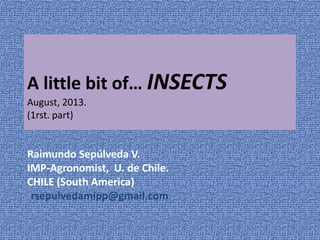Insects1(englishversion)
•
0 gostou•695 visualizações
First and introductory Chapter about Insects. This slide is one among others. The author.
Denunciar
Compartilhar
Denunciar
Compartilhar
Baixar para ler offline

Recomendados
Mais conteúdo relacionado
Mais procurados
Mais procurados (20)
023 - Aqua Latin 101 (Tank Talk 35-04 - December 2007)

023 - Aqua Latin 101 (Tank Talk 35-04 - December 2007)
Understanding phyla dichotomous key steps and classification part 2

Understanding phyla dichotomous key steps and classification part 2
Circumscription of a monophyletic family for the tapaculos (aves rhinocryptid...

Circumscription of a monophyletic family for the tapaculos (aves rhinocryptid...
Chapter 1 section 4 (how are living things classified) 2011

Chapter 1 section 4 (how are living things classified) 2011
Destaque
Destaque (19)
Semelhante a Insects1(englishversion)
Semelhante a Insects1(englishversion) (20)
Último
Making communications land - Are they received and understood as intended? webinar
Thursday 2 May 2024
A joint webinar created by the APM Enabling Change and APM People Interest Networks, this is the third of our three part series on Making Communications Land.
presented by
Ian Cribbes, Director, IMC&T Ltd
@cribbesheet
The link to the write up page and resources of this webinar:
https://www.apm.org.uk/news/making-communications-land-are-they-received-and-understood-as-intended-webinar/
Content description:
How do we ensure that what we have communicated was received and understood as we intended and how do we course correct if it has not.Making communications land - Are they received and understood as intended? we...

Making communications land - Are they received and understood as intended? we...Association for Project Management
Mehran University Newsletter is a Quarterly Publication from Public Relations OfficeMehran University Newsletter Vol-X, Issue-I, 2024

Mehran University Newsletter Vol-X, Issue-I, 2024Mehran University of Engineering & Technology, Jamshoro
Último (20)
Food safety_Challenges food safety laboratories_.pdf

Food safety_Challenges food safety laboratories_.pdf
Making communications land - Are they received and understood as intended? we...

Making communications land - Are they received and understood as intended? we...
Kodo Millet PPT made by Ghanshyam bairwa college of Agriculture kumher bhara...

Kodo Millet PPT made by Ghanshyam bairwa college of Agriculture kumher bhara...
Unit-V; Pricing (Pharma Marketing Management).pptx

Unit-V; Pricing (Pharma Marketing Management).pptx
This PowerPoint helps students to consider the concept of infinity.

This PowerPoint helps students to consider the concept of infinity.
Unit-IV; Professional Sales Representative (PSR).pptx

Unit-IV; Professional Sales Representative (PSR).pptx
Insects1(englishversion)
- 1. A little bit of… INSECTS August, 2013. (1rst. part) Raimundo Sepúlveda V. IPM-Agronomist, U. de Chile. CHILE (South America) rsepulvedamipp@gmail.com
- 2. Introduction… There are many forms to tackle the great topics of INSECTS. A classics way is starting with biodiversity of our planet (huge numbers, different types); another it could be studying the fossil register with first insects (perhaps with mistakes); or simply to talk about the successfuly 6 legs-animals (hexapodes) that live everywhere. Whatever be the beginning, Insects are special animals that have known to colonize Earth since aprox. 400 millions years; even us, the modern man, has not did this. So, we must look and observe Insects with attention, respect and fascination.
- 3. Figure 1. A “7 pointed-ladybug”, a good example of insect. Look its body divided in 3 parts and 6 legs (1). 3
- 4. General ideas… Entomology is the science that studies Insects and its specialist it is called entomologist. In general, with some exceptions, an Insect has 3 parts: 1) Head, 2) Thorax y 3) Abdomen. For this reason, some scientists call them “three segmented animals” (in 3 sections). The general rule says that they have a external skeleton (exo- skeleton) of chitin; besides, they have 2 antennas, 6 legs when are adults and 4 wings, as maximum. Colours and designs show a great variety and they are related to their habitats or living places. Sizes= a very wide range. Insects are 0,25mm up to 360mm long, aprox. See Figure 2.
- 5. Figure 2. A “peach (tree) green aphid”. We see its winged phase with long antennas and legs (2). 5
- 6. Classification… All Sciences need Classification (taxonomic or systematics) because classification put things in order and this make the study easier. However, there are many kinds of classifications and the selected-one depends on what we are looking for. In Entomology, we usually prefer and remember the design of insects wings, using the greek word “pteron” (=wing). Then, with this, entomologists created categories, such as: Coleoptera (coleos+pteron) and Lepidoptera (lepidos+pteron), that include (in the same order) “beetles” and “butterflies”. See Figure 3.
- 7. Figura 3. A beauty “silvered blue butterfly” (Heliconius sp.). It is clasificated into Lepidoptera, due to its 4 wings with little and coloured scales (3). 7
- 8. Final comments… Entomologists have named, at least, a million of Insects. Others scientists have said “for each person on Earth, there are millions or billions of insects”. So, we could conclude that human beings are living on the planet of Insects!. Have a good day… (to be continued)
- 9. Images credits… 1.- 100ceros.blogspot.com 2.- www.ars.usda.gov 3.- logos77.wordpress.com Recommended links… 1.- http://entomology.ucdavis.edu/ 2.- http://www.surmagico.cl/el_color_de_las_mariposas.htm Recommended books (in Spanish)… 1.- Peña, L. 2007. Introducción al estudio de los Insectos de Chile. Ed. Universitaria. Santiago, Chile. 264p. 2.- Sepúlveda, R. 2013. Apuntes de la Cátedra “Técnicas de Control de Plagas y Enfermedades…” UTCh-Inacap. Santiago, Chile. 117p. 9
